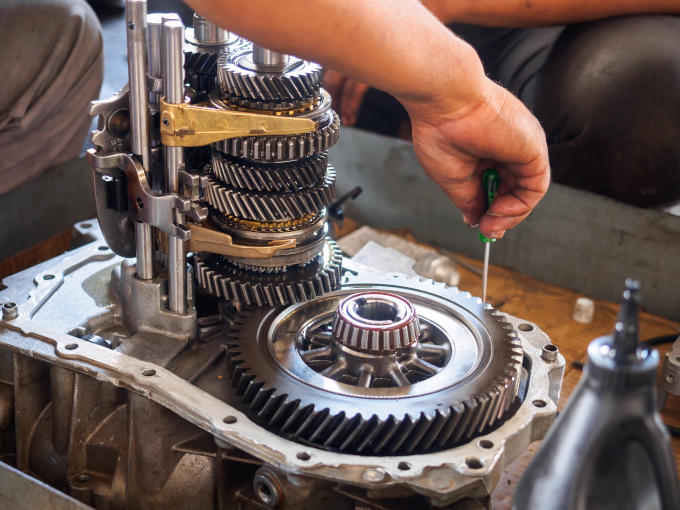Transmission failure can be a stressful and costly prospect to many vehicle owners, especially when transmission repair seems a bit like a black box.
AAMCO Centers of Southern California are here to shine some light on the process of transmission repair to ease your mind and ensure you have the right information to make the best choice. We’ll help guide you every step of the way to get you back on the road quickly and safely.
What Are the Types of Transmission Repair?
Transmission repair falls into two categories: rebuilt or remanufactured. While the outcome is the same—a fully functioning transmission—there are some key differences between the two.
What is a Transmission Rebuild?
A rebuild refers to a rebuilding of the original transmission. In this type of repair, parts from the old transmission are reused in making the new one. Rebuilds are usually much cheaper than remanufactured transmissions.
The Process
The first step is disassembling the old transmission. The transmission case and all components are removed and placed on a workbench for inspection.
At this point, each component is thoroughly cleaned and inspected for damage or wear before reuse. Any worn parts are replaced with new ones at this time, such as clutches, bands, seals, gaskets, etc.
Once the cleaning and inspection are finished, the remanufactured transmission is reassembled.
The next step is testing the rebuilt transmission. This step determines whether or not the rebuild was successful and identifies any additional problems with the unit.
The test includes running the transmission through a simulated road course and checking for leaks and vibrations under load. If all goes well, the repair is complete.
What is a Remanufactured Transmission?
As the name suggests, remanufactured transmissions are completely rebuilt from the ground up. In other words, each part of the transmission is new or replaced with a new version of itself (i.e., a new clutch assembly).
The advantage to a remanufactured transmission is that it is built with all new components. Because of this, there is less wear and tear on these parts than you would find with a rebuilt unit.
The Process
Like a rebuild, the first step in remanufacturing a transmission is disassembling the old unit. However, remanufactured transmissions are serviced by an authorized dealer, giving them access to the original manufacturer's (OEM) parts.
The process for remanufacturing a transmission is much more rigorous than for rebuilding.
Every component is closely inspected and tested for compatibility and quality. If a new part is needed, it is sourced from the OEM.
Once all the components are replaced or refurbished, the transmission is reassembled and undergoes a comprehensive testing process.
The manufacturer will then send the remanufactured transmission to you or your chosen installer, who will then install the new transmission into your vehicle.
What is OEM?
OEM refers to the original equipment manufacturer. In the case of a remanufactured transmission, this means that all parts are sourced from and meet the quality standards set forth by the manufacturer (e.g., Honda, Mercedes-Benz).
Remanufactured transmissions come with a warranty and guarantee for how long they will provide reliable service (usually between 12 to 36 months). Access to OEM parts is a preference of the owner and may take longer to source.
The Remanufactured Transmission Test
While this step is essentially the same as a rebuild, it does have one big difference. If any defects or problems come up during the testing of a remanufactured transmission, they are most likely covered under warranty.
The test is similar to the rebuild test but includes a stress test on components like the torque converter using a dynamometer.
A dynamometer is an instrument used to measure power or torque. The manufacturer measures the unit’s power output under load to determine if a rebuilt or remanufactured transmission will provide adequate service. This test also verifies that components are not defective and ready for installation.
If the remanufactured transmission passes testing, it is good to go. The unit should provide reliable service for up to 36 months or more, depending on the manufacturer's warranty.
Which Should I Choose? Pros and Cons
So, which transmission fix is right for your vehicle? There are pros and cons to both rebuilds and remanufactures, so carefully consider which will benefit you most.
Rebuilt Transmission Pros and Cons
Pros
- Cheaper than a remanufactured transmission.
- Faster, due to now waiting on remanufactured transmission and subsequent installation.
Cons
- Typically, OEM parts are not used unless access to parts is cheaper than alternatives.
- Parts may not be covered by warranties.
- Quality of outcome is based on the mechanic or team rebuilding the transmission.
Remanufactured Transmission Pros and Cons
Pros
- Uses OEM parts
- Higher quality than a rebuilt transmission
- Warranty typically covers any defects found during testing
Cons
- More expensive than a rebuilt transmission
- Usually needs to be installed by a professional, which may add to the cost
- Process may take longer
Are Rebuilt Transmissions as Good as Remanufactured Transmissions?
It may be tempting to think that one type of transmission repair is better than the other. However, the final performance comes down to a few different aspects:
1. The Extent of Transmission Damage
The degree of transmission damage and the number of parts that need replacement will define whether a rebuild or remanufacture is best.
If you need your whole transmission replaced, then a remanufactured transmission might be the only option.
However, if there are just one or two faulty components, it might be cheaper to use rebuilt parts instead.
2. The Parts Used
Remanufactured transmissions use OEM (original equipment manufacturer) parts. This means that they are of the same quality and durability as the parts used in the original transmission. Rebuilt transmissions may not use OEM parts, which can affect the quality of the rebuild.
3. The Quality Control Process
Any defects or problems found during the testing process of a remanufactured transmission are usually covered by warranty. This is not always the case with rebuilt transmissions. However, most mechanics will ensure that their service offers quality control.
4. The Technical Expertise
Building a quality rebuild takes expertise and care. A poorly rebuilt transmission can do more damage than good and may even require a new transmission to be installed. If you are considering a rebuilt transmission, go to a transmission specialist.
5. The Warranty
Remanufactured transmissions typically come with a warranty, which guarantees the quality of the transmission for a certain period of time. Rebuilt transmissions may not have a warranty.
Which Transmission Fix is Right for Me?
Transmission problems can be challenging to diagnose and even harder to fix. So, which transmission fix is right for you?
If you're on a budget and want a quicker fix, a rebuilt transmission may be the best option.
However, if you want the benefit of knowing that your transmission was serviced with OEM parts, then a remanufactured transmission is the alternative.
Transmission problems can be expensive and dangerous if not fixed properly. Work directly with a certified mechanic or authorized dealership to get your transmission running smoothly again.
We're Here to Help
AAMCO has more than 60 years of experience diagnosing, servicing, and repairing more than 20 million vehicles. Customers rely on us for:
- Quality repairs
- Expert technicians
- Superior customer experience
- Trustworthy, honest service
- Best warranty coverage available
AAMCO Centers of Southern California and surrounding areas represent trust, quality, and value. If you’re having cooling system trouble, call us today!

 Schedule Appointment
Schedule Appointment















